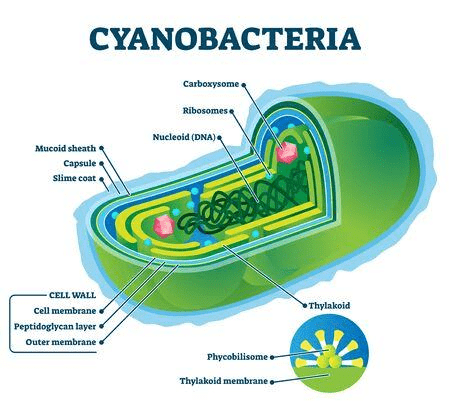NCERT Exemplar: Plant Kingdom | Biology Class 11 - NEET PDF Download
| Table of contents |

|
| Multiple Choice Questions |

|
| Very Short Answer Type Questions |

|
| Short Answer Type Questions |

|
| Long Answer Type Questions |

|
Multiple Choice Questions
Q.1. Cyanobacteria are classified under
(a) Protista
(b) Plantae
(c) Monera
(d) Algae
Ans. (c)
Cyanobacteria are classified under Kingdom Monera.
- They are also known as blue-green algae, but they are not technically classified as algae.
- Cyanobacteria are a type of bacteria that are photosynthetic, meaning they can make their own food using sunlight, similar to plants.
(i) Protista— unicellular eukaryotes
(ii) Plantae, all members of Kingdom Plantae are eukaryotic chloroplast chlorophyll-containing organisms commonly called plants. These are autotrophic/holophytic.
Q.2. The fusion of two motile gametes that are dissimilar in size is termed as
(a) Oogamy
(b) Isogamy
(c) Anisogamy
(d) Zoogamy
Ans. (c)
The fusion of two motile gametes that are dissimilar in size is termed as anisogamy.
In Anisogamy, the gametes that fuse are of different sizes and shapes. Typically, one gamete is larger and non-motile (called the egg or ovum) while the other gamete is smaller and motile (called the sperm). Anisogamy is a common form of sexual reproduction in many organisms, including plants and animals, and is different from isogamy, where the gametes are of the same size and shape. Oogamy and Zoogamy are not terms used to describe the fusion of gametes with different sizes.
Anisogamy of two Motile gametes
Q.3. Holdfast, stipe, and frond constitutes the plant body in case of
(a) Rhodophyceae
(b) Chlorophyceae
(c) Phaeophyceae
(d) All of the above
Ans. (c)
- Holdfast, stipe, and frond constitute the plant body of Phaeophyceae or brown algae.
- The holdfast is a root-like structure that anchors the algae to a surface, the stipe is a stem-like structure that supports the frond, which is a leaf-like structure.
- Brown algae are multicellular and photosynthetic organisms that are mostly found in marine environments.
- They are the largest and most complex of all seaweeds and are commonly known as kelp.
Q.4. A plant shows a thallus level of organization. It shows rhizoids and is haploid. It needs water to complete its life cycle because the male gametes are motile. Identify the group to which it belongs to
(a) Pteridophytes
(b) Gymnosperms
(c) Monocots
(d) Bryophytes
Ans. (d)
- The plant that shows a thallus level of organization, has rhizoids and is haploid, and needs water to complete its life cycle because the male gametes are motile belongs to the group Bryophytes.
- Bryophytes are non-vascular plants that lack true roots, stems, and leaves.
- They have a simple plant body organization, which is referred to as thallus.
- Bryophytes include mosses, liverworts, and hornworts.
- They require water for sexual reproduction because the male gametes are motile and need water to swim to the female gametes.
Q.5. A prothallus is
(a) A structure in pteridophytes formed before the thallus develops
(b) A sporophytic free-living structure formed in pteridophytes
(c) A gametophyte free-living structure formed in pteridophytes
(d) A primitive structure formed after fertilization in pteridophytes
Ans. (c)
In pteridophytes, meiosis or R/D occurs at the time of spore formation. The spores germinate to give rise to inconspicuous, small but multicellular, free-living, mostly photosynthetic thalloid gametophytes called prothallus. Prothallus represents the gametophytic phase in pteridophytes.
Q.6. Plants of this group are diploid and well adapted to extreme conditions. They grow bearing sporophylls in compact structures called cones. The group in reference is
(a) Monocots
(b) Dicots
(c) Pteridophytes
(d) Gymnosperms
Ans. (d)
- Plants of this group are diploid and well adapted to extreme conditions. They grow bearing sporophylls in compact structures called cones. The group being referred to is Gymnosperms.
- Gymnosperms are vascular plants that have naked seeds, meaning the seeds are not enclosed in a fruit.
- They have a dominant sporophyte generation and are diploid organisms.
- Gymnosperms are adapted to a variety of extreme environmental conditions, including cold, dry, and nutrient-poor soils.
- They bear cones, which are compact structures that contain reproductive structures called sporophylls.
- Gymnosperms include plants like conifers, cycads, ginkgoes, and gnetophytes.
Q.7. The embryo sac of an Angiosperm is made up of
(a) 8 cells
(b) 7 cells and 8 nuclei
(c) 8 nuclei
(d) 7 cells and 7 nuclei
Ans. (b)
The embryo sac of an Angiosperm is made up of 7 cells and 8 nuclei. The cells are arranged into three antipodal cells, two synergids, an egg cell, and a central cell with two polar nuclei. The nuclei include one egg nucleus, two polar nuclei, three antipodal nuclei, and two synergid nuclei. These cells and nuclei play important roles in fertilization and embryonic development in plants.
Q.8. If the diploid number of a flowering plant is 36. what would be the chromosome number in its endosperm?
(a) 36
(b) 18
(c) 54
(d) 72
Ans. (c)
- The endosperm of a flowering plant is triploid, meaning it has three sets of chromosomes. Therefore, to determine the chromosome number in the endosperm, we need to multiply the diploid number by 3.
So, if the diploid number of a flowering plant is 36, the chromosome number in its endosperm would be: 36 x 3 = 108
- We need to divide by 2 to get the correct answer, as each set of chromosomes comes from a different parent. Therefore, the correct answer is:
108 / 2 = 54So, the chromosome number in the endosperm of a flowering plant with a diploid number of 36 would be 54.
Q.9. Protonema is
(a) Haploid and is found in mosses
(b) Diploid and is found in liverworts
(c) Diploid and is found in pteridophytes
(d) Haploid and is found in pteridophytes
Ans. (a)
Protonema is a haploid structure found in mosses. The predominant stage of the life cycle of a moss is the gametophyte which consists of two stages. The first stage is the protonema stage (juvenile stage) and the second stage is the leafy stage. Moss protonema resembles multicellular green algae in structure. Moss plant develops from protonema.
Q.10. The giant Redwood tree (Sequoia sempervirens) is a/an.
(a) Angiosperm
(b) Free fern
(c) Pteridophyte
(d) Gymnosperm
Ans. (d)
Solution: One of the gymnosperms, the giant redwood tree Sequoia is one of the tallest tree species.
Very Short Answer Type Questions
Q.1. Food is stored as Floridian starch in Rhodophyceae. Mannitol is the reserve food material of which group of algae?
Ans. Mannitol is the reserve food material of brown algae or Phaeophyceae.
Q.2. Give an example of plants with
(a) Haplontic life cycle
(b) Diplontic life cycle
(c) Haplo-diplontic life cycle
Ans.
(a) Haplontic life cycle—Volvox, Spirogyra, and some species of Chlamydomonas
(b) Diplontic life cycle—AH seed-bearing plants, i.e. (gymnosperms and angiosperms)
(c) Haplo-diplontic life cycle—Bryophytes and Pteridophytes
Q.3. The plant body in higher plants is well-differentiated and well developed. Roots are the organs used for the purpose of absorption. What is the equivalent of roots in the less developed lower plants?
Ans. In lower plants like algae, the holdfast is present and in bryophytes, rhizoids are present instead of roots.
Q.4. Most algal genera show haplontic life style. Name an alga which is
(a) Haplo-diplontic
(b) Diplontic
Ans.
(a) Haplo-diplontic—Ectocarpus, Polysiphonia and Kelps
(b) Diplontic—Fucus
Q.5. In Bryophytes male and female sex organs are called ______ and ______.
Ans. In Bryophytes male sex organ is called antheridium and the female sex organ is called archegonium.
Short Answer Type Questions
Q.1. Why are bryophytes called the amphibians of the plant kingdom?
Ans. Bryophytes are also called amphibians of the plant kingdom because these plants can live in soil but are dependent on water for sexual reproduction.
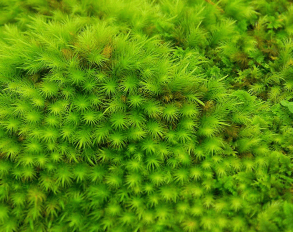 Bryophytes
Bryophytes
Q.2. The male and female reproductive organs of several pteridophytes and gymnosperms are comparable to floral structures of angiosperms. Make an attempt to compare the various reproductive parts of pteridophytes and gymnosperms with reproductive structures of angiosperms
Ans.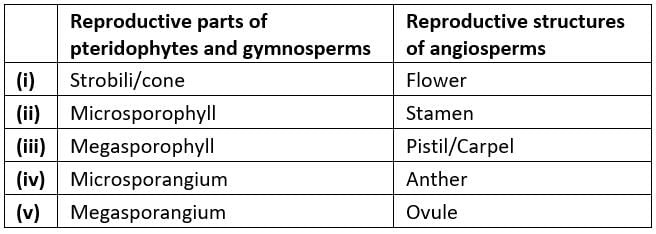
Q.3. Heterospory i.e., the formation of two types of spores — microspores and megaspores is a characteristic feature in the life cycle of a few members of pteridophytes and all spermatophytes. Do you think heterospory has some evolutionary significance in the plant kingdom?
Ans. Heterospory involves formation of two types of spores. Microspores are smaller in size and megaspores are much larger in size. In some Pteridophytes, the microspores and megaspore germinate to give rise to male and female gametophytes respectively. Finally, the zygote develops inside the female gametophyte. From evolutionary perspective, this is a precursor of seed habit in higher plants. Seeds have enabled gymnosperms and angiosperms to tide over long periods of unfavourable conditions. Seeds have also enabled them to spread to wider geographical area through seed dispersal. It has indeed helped these plants in further evolution.
Q.4. How far does Selaginella one of the few living members of lycopodiales (pteridophytes) fall short of seed habit?
Ans. Selaginella produces two kinds of spores, macro (large) and micro (small) spores. The megaspores and microspores germinate and give rise to female and male gametophytes, respectively. But Selaginella falls short of seed habit due to lack of integument around the megasporangium.
Q.5. Each plant or group of plants has some phylogenetic significance in relation to evolution: Cycas, one of the few living members of gymnosperms is called the ‘relic of past’. Can you establish a phylogenetic relationship of Cycas with any other group of plants that justifies the above statement?
Ans. Cycas, one of the few living members of gymnosperms is called the ‘relic of past’ because it shows many characteristics that are similar to pteridophytes, like, flagellated antherozoids, circinate ptyxis, megasporophyll is leaf-like, presence of archegonia, etc.
Q.6. The heterosporous pteridophytes show certain characteristics, which are precursors to the seed habit in gymnosperms. Explain.
Ans. In the majority of the pteridophytes, all the spores are of similar kinds, such plants are called homosporous. Genera like Selaginella, Salvinia, Marsilea, and Azolla which produce two kinds of spores, macro (large) and micro (small) spores, are known as heterosporous. The megaspores and microspores germinate and give rise to female and male gametophytes, respectively.
The female gametophytes in these plants are retained on the parent sporophytes for variable periods. The development of the zygotes into young embryos takes place within the female gametophytes. This event is a precursor to the seed habit considered an important step in evolution.
Q.7. Comment on the lifecycle and nature of a fern prothallus.
Ans.
- The diploid sporophyte is represented by a dominant, independent, photosynthetic, vascular plant body. It alternates with multicellular, saprophytic/autotrophic, independent but short-lived haploid gametophyte called prothallus. Such a pattern is known as haplo-diplontic life cycle. All pteridophytes exhibit this pattern.
- These gametophytes require cool, damp, shady places to grow. Because of this specific restricted requirement and the need for water for fertilization, the spread of living pteridophytes is limited and restricted to narrow geographical regions. The gametophytes (prothallus) bear male and female sex organs called antheridia and archegonia, respectively.
- Water is required for the transfer of antherozoids—the male gametes released from the antheridia to the mouth of the archegonium. The male gamete's fusion with the egg present in the archegonium results in the foundation of the zygote.
- Zygote thereafter produces a multicellular well-differentiated sporophyte which is the dominant phase of the pteridophytes.
Q.8. How are the male and female gametophytes of pteridophytes and gymnosperms different from each other?
Ans. Male and female gametophytes of pteridophytes are free-living while in gymnosperms male and female gametophytes do not have free-living existence. They remain within the sporangia retained on sporophytes.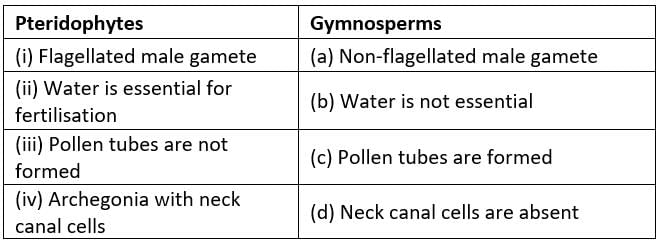
Q.9. In which plant will you look for mycorrhiza and coralloid roots? Also, explain what these terms mean.
Ans. Roots in some genera have a fungal association in the form of mycorrhiza (Finns), while in some others (Cvms) small specialized roots called coralloid roots are associated with N2-fixing cyanobacteria.
Long Answer Type Questions
Q.1. The gametophyte is a dominant phase in the life cycle of a bryophyte. Explain.
Ans.
- The main plant body of the bryophyte is haploid. It produces gametes, hence is called a gametophyte. The sex organs in bryophytes are multicellular.
The male sex organ is called the antheridium. They produce biflagellate antherozoids or ciliated sperms. - The female sex organ called archegonium is flask-shaped and produces a single egg. The antherozoids are released into the water where they come in contact with archegonium. An antherozoid fuses with the egg to produce the zygote. The zygote does not undergo reduction division immediately. They produce a multicellular body called a sporophyte.
Q.2. With the help of a schematic diagram, describe the haplo–diplontic life cycle pattern of a plant group.
Ans.
- In a sexually reproducing plant, there is an alternation of generation between a haploid and a diploid phase of plant bodies. The haploid plant body is termed gametophyte while the diploid plant body is called the sporophyte.
- The gametophyte produces gametes by mitosis while the haploid spores are produced by sporophyte following meiosis (reduction division). Two gamete fuse together to produce a zygote which develops into the diploid sporophyte.
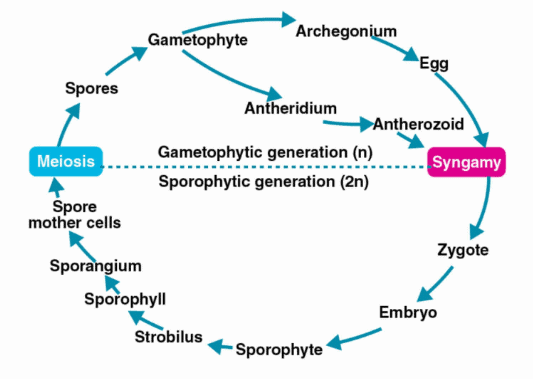 Haplodiplontic Life Cycle
Haplodiplontic Life Cycle - In a haplodiplontic life cycle pattern, such as in Bryophyta or Pteridophyta, both the phases of life are multicellular. However, in bryophytes, the gametophytes are small, photosynthetic, independent, and represent the dominant phase. The partly or totally dependent sporophyte is physically attached to the gametophyte.
- The (n) spores dispersed by sporophyte germinate into individual gametophytic plants. However, in pteridophytes, the 2n (diploid) phase is dominant, well organized, independent while the n phase though also free-living and independent is short-lived and photosynthetic.
- In both of these groups of plants the mobile male gametes, antherozoid produced by sex organ antheridium, travel to archegonium (bearing an egg cell) via the medium of water. The egg cell is non-motile hence the reproduction is oogamous.
Q.3. Lichen is usually cited as an example of symbiosis in plants where an algal and a fungal species live together for their mutual benefit. Which of the following will happen if algal and fungal partners are separated from each other?
(a) Both will survive and grow normally and independently from each other.
(b) Both will die.
(c) Algal component will survive while the fungal component will die.
(d) Fungal component will survive while the algal partner will die.
Based on your answer how do you justify this association as symbiosis?
Ans.
- Lichen is usually cited as an example of symbiosis in biology wherein a fungal and an algal species live together for mutual benefit. The algal component synthesizes the food through photosynthesis which is utilized by the fungal species for its survival. The fungal component in return provides shelter and waste products that are consumed by algal species.
- Experiments though have shown that algal components can grow independently when separated from fungal species. But the same is not true with the fungal component which dies when separated from the algal component. This association is, therefore, a typical case of a master-slave relationship where fungus (master) has trapped the algal components (slave) for its own survival while giving nothing in return to it.
- Some authors consider this association as controlled parasitism or helotism due to the fact that sometimes the fungus sends its haustoria into the algal cells to derive nourishment.
Q.4. Explain why sexual reproduction in angiosperms is said to take place through double fertilization and triple fusion. Also, draw a labeled diagram of the embryo sac to explain the phenomena.
Ans. Here are the points explaining why sexual reproduction in angiosperms is said to take place through double fertilization and triple fusion:
- Double fertilization involves the fusion of two sperm cells with two different cells in the female gametophyte of the plant.
- One sperm cell fuses with the egg cell to form a diploid zygote, which develops into the embryo.
- The other sperm cell fuses with two polar nuclei to form a triploid endosperm, which provides nutrition to the developing embryo.
- Double fertilization ensures that the endosperm is only formed when there is a successful fertilization of the egg cell.
- Triple fusion occurs when one sperm cell fuses with two polar nuclei, resulting in the formation of the triploid endosperm nucleus.
- Triple fusion helps in maintaining the ploidy level of the endosperm, which is important for the proper development of the embryo.
- Double fertilization and triple fusion are unique to angiosperms and ensure that the plant embryo is well-nourished and has the necessary resources for successful development.
 Triple Fusion
Triple Fusion
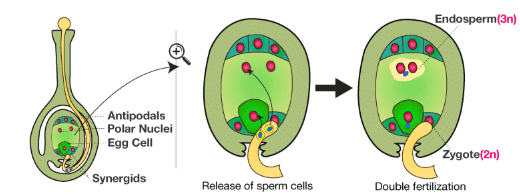 Double Fertilisation
Double Fertilisation
Q.5. Draw labelled diagrams of
(a) Female and male thallus of a liverwort.
(b) Gametophyte and sporophyte of Funaria.
(c) Alternation of generation in Angiosperm.
Ans.
(a) Female and male thallus of a liverwort.
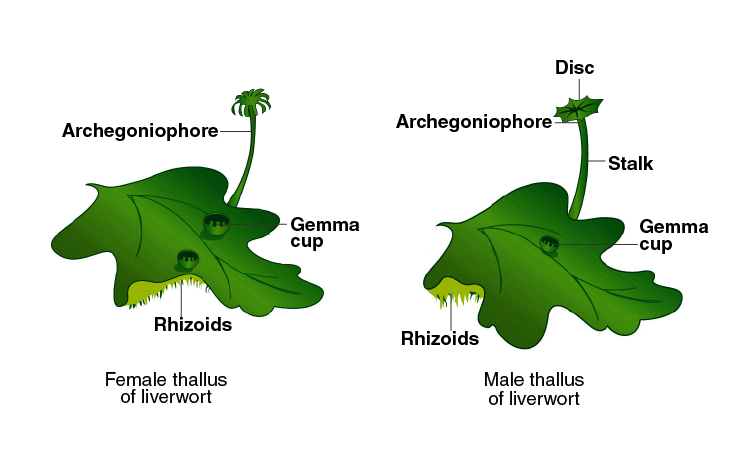
(b) Gametophyte and sporophyte of Funaria.
 Funaria
Funaria
(c) Alternation of generation in Angiosperm. Alternation of Generation
Alternation of Generation
|
169 videos|524 docs|136 tests
|
FAQs on NCERT Exemplar: Plant Kingdom - Biology Class 11 - NEET
| 1. What is the importance of plant kingdom in NEET? |  |
| 2. What are the different types of questions that can be expected from the plant kingdom in NEET? |  |
| 3. How can one prepare effectively for the plant kingdom section in NEET? |  |
| 4. Are there any specific topics within the plant kingdom that are frequently asked in NEET? |  |
| 5. Can you provide some tips to remember the different plant families and their characteristics for NEET? |  |

